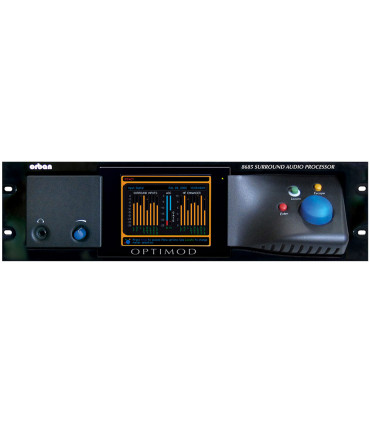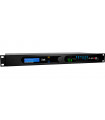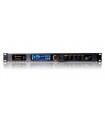Orban Optimod-TV 8685
Surround Loudness Controller
Orban's flagship OPTIMOD TV 8685 surround/stereo television loudness controller draws on Orban's more than 30 years of experience in television audio processing to provide audibly transparent automatic loudness control and dialogue intelligibility control for one surround (up to 7.1) and four stereo programs simultaneously. Stereo processing can operate in dual-mono mode, so it can process four subchannels in stereo or eight subchannels in mono.
Women's clothing size
| Size | XS | S | M | L |
|---|---|---|---|---|
| Euro | 32/34 | 36 | 38 | 40 |
| USA | 0/2 | 4 | 6 | 8 |
| Bust(in) | 31-32 | 33 | 34 | 36 |
| Bust(cm) | 80.5-82.5 | 84.5 | 87 | 92 |
| Waist(in) | 24-25 | 26 | 27 | 29 |
| Waist(cm) | 62.5-64.5 | 66.5 | 69 | 74 |
| Hips(in) | 34-35 | 36 | 37 | 39 |
| Hips(cm) | 87.5-89.5 | 91.5 | 94 | 99 |
With your arms relaxed at your sides, measure around the fullest part of your chest.
Measure around the narrowest part of your natural waist, generally around the belly button. To ensure a comfortable fit, keep one finger between the measuring tape and your body.
Orban Optimod-TV 8685
Surround Loudness Controller
Orban's flagship OPTIMOD TV 8685 surround/stereo television loudness controller builds on Orban's 30+ years experience in television audio processing to provide audibly transparent automatic loudness control and dialog intelligibility control for one surround program (up to 7.1) and four stereo programs simultaneously. The stereo processing can operate in dual-mono mode, so it can process four subchannels in stereo or eight subchannels in mono. The OPTIMOD TV 8685 is Orban's second-generation surround/2.0 processor offers standard AES3id and SD, HD-SDI (3G) input/output and audio routing capabilities. Dual redundant power supplies help ensure maximum uptime where a relay provides hard-wire safety bypass from the SDI input to the SDI output in case of hardware failure. The OPTIMOD TV 8685 is dialnorm-aware. Loudness control is excellent when measured by the ITU BS.1770 standard (as specified in ATSC A/85:2013) or by the OPTIMOD TV 8685's built-in CBS Loudness Meters. When properly installed and set up, the OPTIMOD TV 8685 will automatically make a station compliant with the CALM Act or EBU R128. In stereo mode, the four stereo processors can be made pre-emphasis aware, allowing the OPTIMOD TV 8685 to be purchased for immediate use with analog transmitters with the assurance that it will provide no-compromise processing for digital transmissions when the need arises. A second use for the stereo processors is processing up to four different languages in DTV program streams.
Absolute Control of Loudness and Peak Modulation
The OPTIMOD TV 8685 includes third-generation CBS Loudness Controllers for DTV applications. Separate loudness controllers are available in the multichannel and 2.0 processing chains and work with the both Two-Band and Five-Band structures. The third-generation improvements reduce annoyance more than simple loudness control alone, doing so without audible gain pumping. Attack time is fast enough to prevent audible loudness overshoots, so the control is smooth and unobtrusive. Loudness control is excellent when measured by the OPTIMOD TV 8685's built-in ITU BS.1770 and second-generation (Jones & Torick) CBS Loudness Meters, allowing stations to comply automatically with the requirements of the CALM act. The OPTIMOD TV 8685 implements “true peak” control by oversampling the peak limiter's sidechain at 192 kHz. This allows the OPTIMOD TV 8685 to prevent clipping in a playback device's analog signal path by predicting and controlling the analog peak level following the playback device's reconstruction filter to an accuracy of better than 0.5 dB. For typical program material, accuracy is 0.2 dB. Without true peak control, analog clipping can occur even if all peak values of the digital samples are below 0 dBFS. This phenomenon has also been termed “0 dBFS+.” Thanks to true peak control, sample rate conversion, unless it removes high frequency program energy or introduces group delay distortion, cannot cause sample peaks to increase more than 0.5 dB. For example, sample rate conversion from 48 kHz to 44.1 kHz is highly unlikely to cause sample peak clipping in the 44.1 kHz audio data.
Orban's Optimix Upmixer
The built-in, Orban-developed Optimix stereo to 5.0 surround upmixer provides uncolored automatic stereo-to-surround upmixing, plus phase correction that ensures that the center channel is always crisp and intelligible. Optimix stereo 5.0 surround upmixer is 5.1-compatible. Unlike technology derived from consumer matrix decoders, there is no program-dependent directional pumping of sound sources. Unique to this technology is extremely robust center channel phase/skew correction that never causes negative side effects. It is invaluable for older material that was originally recorded on analog tape. Optimix's output downmixes to stereo flawlessly, and the skew correction often makes the downmix sound better than the original stereo!
Adaptability through Multiple Audio Processing Structures
The OPTIMOD TV 8685 features two processing structures: Five-Band for a spectrally consistent sound and Two-Band for a more transparent sound that preserves the frequency balance of the original program material. A special Two-Band preset creates a no-compromise “Protect” function that is functionally similar to the “Protect” structures in earlier Orban digital processors.
The Five-Band and the Two-Band structures can be switched via a mute-free crossfade. Audio processing can be smoothly activated and defeated on-air, allowing programs that can benefit from full dynamic range to pass through the OPTIMOD TV 8685 without dynamics compression.
There are two distinct kinds of presets in OPTIMOD TV 8685: processing presets, which contain the settings of the 8685's audio processing controls (like compression thresholds), and setups, which contain technical setup settings (like input reference settings and channel routing). You can modify presets and setups and save them as “user presets” and “user setups.” More then 20 factory presets can be categorized into 4 groups. Digital TV, Analog TV, Digital radio and “Pass through”.
Flexible Configuration
The OPTIMOD TV 8685 features 3G HD-SDI and AES3id input/output, plus comprehensive handling of metadata. The HD-SDI I/O section supports SD-SDI (per SMPTE 259M); 1.5 Gbit/s HD-SDI (per SMPTE 292M; up to 720p and 1080i) and 3.0 Gbit/s single-wire HD-SDI (per SMPTE 424M; 1080p). The SDI I/O can de-embed up to 16 channels of audio, send them to the 8685's DSP for audio processing, and then re-embed them with video that has been delayed to maintain AV-sync. A relay provides hard-wire safety bypass from the SDI input to the SDI output in case of hardware failure.
Is Dialnorm-aware and can re-author metadata as needed. Seamless switching between processing and pass-through modes (where both audio and metadata are passed through without further processing) allows the 8685 to pass pre-qualified material without modification—you can use the OPTIMOD transparent-sounding loudness control only when needed. This makes it easy to comply with the requirements of network program providers who preprocess their audio feeds to comply with Recommendations A/85 and R-128. The 8685 can accept and emit Dolby-E metadata via RS485 serial (per SMPTE RDD 6-2008), and SDI [per SMPTE 2020-2-2008 (Method-A) and SMPTE 2020-3-2008 (Method-B)].
OPTIMOD TV 8685's inputs and outputs are highly configurable via remote controllable internal routing switchers. Additionally, the outputs of the multichannel and 2.0 processing chains can be independently configured to emit the output of the AGC or the output of the multiband compressor/limiter, all configurable to use or bypass look-ahead true peak limiting.
Via the internal output routing switcher, a given output signal can be applied to more than one hardware output. This allows using the 8685 as an AES splitter.
A stereo analog monitor output appears on XLR connectors on the rear panel. It can be configured to emit any OPTIMOD TV 8685 output signal, including a downmix of the multichannel audio. The analog outputs are transformerless, balanced, and floating (with 50Ω impedance) to ensure highest transparency and accurate pulse response. They can be used to drive a transmitter, although their normal function is monitoring. A stereo headphone jack is available on the front panel. It can be configured to emit any output signal and is independent of the stereo analog monitor output.
An audio sync input is configurable to accept AES11id or wordclock sync. You can synchronize the output sample rate of all AES3id outputs to this input. You can also synchronize the outputs to the AES3 digital input #1 or to the OPTIMOD TV 8685's internal clock. The sync source of each AES3 output is independently selectable. A BNC connector can accept video sync per SMPTE 274M and SMPTE 296M, which can be used as a reference for the output audio sample rate and to correctly align Dolby-E frames with video per Dolby's requirements. The signal applied to the SDI input can also be used as a sync reference. The OPTIMOD TV 8685 contains a versatile real-time clock, which allows automation of various events (including recalling presets) at pre-programmed times. To ensure accuracy, the clock can be synchronized to an Internet timeserver
Freescale 24-bit DSP chips do all audio processing while a separate microcontroller supports the GUI and control functions. An API provides remote administration over TCP/IP via the RS232 serial or Ethernet ports. The OPTIMOD TV 8685 hosts a TCP/IP terminal server to allow external control of the OPTIMOD TV 8685 from either a Telnet/SSH client or a custom third party application. All commands are simple text strings. You can recall presets, operate the input and output routing switchers and more. Password security is provided. By running Orban-supplied downloadable upgrade software on a PC. The upgrade can occur remotely through the OPTIMOD TV 8685's Ethernet port or serial port (connected to an external modem), or locally (by connecting a Windows computer to the OPTIMOD TV 8685's serial port through the supplied null modem cable).
Absolute Control of Loudness and Peak Modulation
-The 8685 includes third-generation CBS Loudness Controller and BS.1770 safety limiters for DTV applications. Separate loudness controllers and safety limiters are available in the multichannel and 2.0 processing chains and work with the both the Two-Band and Five-Band structures. The third-generation improvements reduce annoyance more than simple loudness control alone, doing so without audible gain pumping. Attack time is fast enough to prevent audible loudness overshoots, so the control is smooth and unobtrusive. Loudness control is excellent when measured by the ITU BS.1770 or EBU R-128 standards or by the 8685's built-in CBS Loudness Meters, allowing stations to comply effortlessly with the requirements of the CALM act.
New in Version 1.1 software is a "BS.1770 Safety Limiter" which can further improve the measured performance using the BS.1770 meter and which was added for the benefit of organizations with strict objective limits on the indication of a BS.1770-4 meter regardless of the actual subjective loudness as determined by human listeners. Using the ITU BS.1770 and CBS Loudness Meters To Measure Loudness Controller Performance
-Optimix is a premium-quality, Orban-designed stereo-to-surround upmixer for the Optimod 8685 and 6585 Surround Loudness Controllers. It runs in the Optimod's internal DSP and is provided at no additional charge.
-The upmix is artifact-free and sounds convincingly like true surround material. It is directionally stable with a solid center channel and excellent envelopment, and it avoids the “image steering pumping” introduced by consumer upmixers that have been repurposed for transmission.
-A highly robust, Orban-proprietary algorithm eliminates the effects of phase and azimuth skew in the upmix, ensuring crisp, highly intelligible dialog and other center-channel material. Not only can it correct the effect of vertically misaligned L/R gaps in analog tape heads, but it can even correct the acoustic comb filtering that occurs when one source (like a snare drum) leaks into multiple microphones during the original recording! Hence, the stereo downmix can actually sound more present and detailed than the original stereo input while still preserving its artistic intent.
-Optimix automatically determines whether the input material is two-channel stereo or surround. It does this by detecting energy in the center, left-surround, and right-surround input channels. In automatic switching mode, if it detects energy in any of these channels, Optimix will immediately bypass the upmixer. If there is no energy in any of these channels, Optimix will create a realistic-sounding surround upmix from stereo input.
-All existing 8685 and 6585 users can upgrade to Optimix via a free software download.
-Precise control of peak levels. The 8685 precisely controls peak levels to prevent digital clipping. The maximum level of the digital samples is controlled to better than 2%.
-Pre-emphasis limiting for the two standard pre-emphasis curves of 50 µs & 75 µs. While primarily oriented toward "flat" media, the 8685's 2.0 channel processors can also provide pre-emphasis limiting for the two standard pre-emphasis curves of 50 µs and 75 µs. This allows them to protect pre-emphasized microwave links, satellite uplinks and similar channels where protection limiting or light processing is required. Note that the 8685's 2.0 channel processing cannot provide simultaneous, independent audio processing for flat and preemphasized channels. Even though one output may be pre-emphasized while other is flat, the only difference between the outputs is that the "flat" output has de-emphasis applied to it after the processing while the preemphasized output does not.
User-Friendly Interface
-Color LCD and large rotary knob. A large (quarter-VGA) color liquid crystal display (LCD) makes setup, adjustment and programming of the 8500 easy. Navigation is by a miniature joystick, two dedicated buttons, and a large rotary knob. The LCD shows all metering functions of the processing structure in use.
-Navigation Joystick. Use the Locate joystick to navigate through a menu that lets you recall a preset, modify processing (at three levels of expertise), or to access the system's setup controls.
Flexible Configuration
-Nine processors in one. A gain-coupled multichannel processor for up to 7.1 channels, plus four additional, independent 2.0 channel processors (whose performance is equivalent to an OPTIMOD 6300) that can be used for many tasks such as processing the audio for a second language and up to three ATSC subchannels. Because its output can be mixed into the LF and RF outputs of the multichannel processing, the primary 2.0 channel processor can also be used to process an independent feed (like the output of a sports truck, news truck, or newsroom) before it is mixed with the station's main multichannel audio path. The audio processing parameters can be set independently for the surround and 2.0 processors. (All 2.0 processors have the same processing parameters.) The 2.0 processors can be operated in dual-mono mode where each mono channel has a dedicated CBS loudness controller, BS.1770 safety limiter, CBS loudness meter, and BS.1770 loudness meter. Hence, the 8685 can simultaneously process up to eight mono audio streams for CALM Act compliance.
-Inputs & Outputs. The 8685 provides 3G HD-SDI I/O, one (+ loop) video sync reference input, four AES3id inputs, and three AESid outputs. All AES3id inputs and outputs are transformer-coupled, appear on BNC connectors, and have 75 Ω impedance. Audio I/O from both the HD-SDI and AES3id ports includes sample rate converters and can operate at 32, 44.1, 48, 88.2 and 96 kHz sample rates.
-Configurations via remote-controllable internal routing switchers. OPTIMOD 8685's inputs and outputs are highly configurable via remote-controllable internal routing switchers with scene memory, allowing various configurations to be recalled easily via GPI, clock-based automation, 8685 PC remote software, Ethernet or serial ASCII commands, and the 8685's front panel. Additionally, the outputs of the multichannel and 2.0 processing chains can be independently configured to emit the output of the AGC or the output of the multiband compressor/limiter, all configurable to use or bypass look-ahead limiting.
-Use 8685 as an AES splitter. Via the internal output routing switcher, a given output signal can be applied to more than one hardware output. This allows using the 8685 as an AES splitter.
-Stereo analog monitor output. For both the base I/O configuration and the HD-SDI module, a stereo analog monitor output appears on XLR connectors on the rear panel. It can be configured to emit any 8685 output signal, including a downmix of the multichannel audio. The analog outputs are transformerless, balanced, and floating (with 50 Ω impedance) to ensure highest transparency and accurate pulse response. They can be used to drive a transmitter, although their normal function is monitoring.
-Stereo headphone jack. A stereo headphone jack is available on the front panel. It can be configured to emit any 8685 output signal and is independent of the stereo analog monitor output.
-BS.1770 loudness meter logging. The 8685 comes with an application for Windows PCs that writes the indications of the 8685's built-in BS 1770 loudness meters to local or network storage. This password-protected application can log the indications whenever the PC is connected to the 8685 via a TCP/IP network. The user can select a logging interval and all readings are time-stamped. The logging application can be configured to automatically send a notification e-mail to a selected address when logging starts or stops.
-Dual-mono mode. The 8685's 2.0 processing offers a dual-mono mode that allows two entirely separate mono programs to be processed, facilitating multiple-language operation. In this mode, both processing channels operate using the same processing parameters (like release time); you cannot adjust the two channels to provide different processing textures.
-Sync Input. An audio sync input is configurable to accept AES11id or wordclock sync. You can synchronize the output samplerate of all AES3id outputs to this input. You can also synchronize the outputs to the AES3 digital input #1 or to the 8685's internal clock. The sync source of each AES3 output is independently selectable.
-Dual power. Dual power supplies with independent AC line inputs provide redundant operation.
-All connections are rigorously RFI-suppressed. All input, output, and power connections are rigorously RFI-suppressed to Orban's traditional exacting standards, ensuring trouble-free installation.
-Certified. The 8685 is designed and certified to meet all applicable international safety and emissions standards.




















































